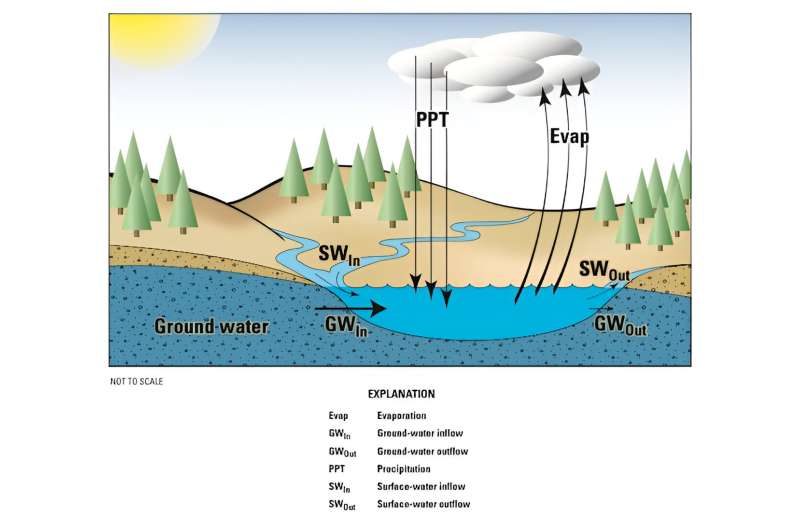This article has been reviewed according to Science X's editorial process and policies. Editors have highlighted the following attributes while ensuring the content's credibility:
fact-checked
trusted source
written by researcher(s)
proofread
Groundwater plays an invisible role supporting lakes

Nearly 90% of North America's lakes are located in Canada. That's why they make up such an enormous part of our landscape. Among their many vital functions, lakes are essential to the biodiversity of our territory and constitute indispensable oases for rest and relaxation.
In the current context, where the climate is changing and humans are putting pressures on the environment in various ways, lakes play an essential role as "sentinels of change." Since they react more quickly to environmental changes than the environments that surround them, lakes can serve as indicators, or even early warning systems.
Canadian lakes are threatened on many fronts. The threats range from eutrophication and pollution to overpumping of the aquifers that feed them, to name just a few.
Because of the potentially devastating effects of these pressures, the way lakes react to these stresses, and in particular the role that groundwater plays in mediating these processes, has increasingly become the subject of multidisciplinary research.
As a professor and doctoral student in the Department of Earth and Atmospheric Sciences at the Université du Québec à Montréal (UQAM), we are particularly interested in studying the role of groundwater in maintaining aquatic ecosystems, especially lakes and wetlands.
To this end, our research is based on data from long-term experimental monitoring sites and on the development of models that describe how these environments function under both current and future climate conditions.
Water balance in lakes
In addition to the most obvious components of the lake water balance, defined by inflows (i.e. precipitation, the flows of tributaries and runoff) and outflows (notably evaporation and outflows at the outlet), groundwater can play an important role in providing a relatively stable supply of water to lakes.
Most lakes are closely linked to what are known as aquifers, i.e. geological formations in which groundwater circulates. Depending on the hydrogeological properties of the aquifers and the climatic context in which they are located, the connections between lakes and groundwater can vary in time and space.
Because of this, it is particularly important to study the aquifers that surround lakes in order to be able to quantify their exchanges. Since researchers do not necessarily have access to these underground networks, they have developed numerous techniques to do this.
How do you measure groundwater in lakes?
At first glance, it may seem impossible to measure the contribution of groundwater to a lake. How can you tell the difference between water from recent rainfall and water that has been in an aquifer? Techniques for estimating the groundwater flows exchanged between lakes and aquifers are either global, direct or indirect.
A global approach that is relatively easy to implement for quantifying the contribution of groundwater to a lake consists, for example, in estimating all the other terms in the water balance. However, this method can result in fairly significant inaccuracies, i.e. the uncertainty in all the terms of the water balance propagates to the uncertainty of the groundwater flow estimate.
Direct measurements can be made using so-called seepage meters, which consist of reservoirs positioned on the sediments at the bottom of a lake that gradually fill with groundwater (or are emptied in the case of lakes that lose water to the surrounding aquifer).
Groundwater volumes are measured and scaled to estimate the contribution of the aquifer to the lake as a whole. Depending on the geological and climatic context, direct measurements have shown that groundwater can make a significant contribution to the water balance of certain lakes.
The use of indirect tracers is based on the physiochemical properties of water. For example, when groundwater flows through an aquifer, it can become contaminated with radon, a noble gas produced by the degradation of uranium naturally present in the rock. The presence of radon is often used to estimate the contribution of groundwater to lakes.
Similarly, when groundwater circulates in an aquifer, it has a relatively constant temperature close to the average air temperature. Water in areas where the aquifer feeds the lake may therefore be colder in summer or warmer in winter than water in other parts of the lake.
Seepage meters and indirect estimates of groundwater flows reaching the lake are based on point measurements that are not necessarily representative of exchanges in the lake as a whole. For this reason, several techniques are often implemented jointly in order to better constrain the measurements.
Climate change and lake hydrology
Thanks to the now widespread power of computers, numerical models are increasingly being used to supplement measurements taken in the field. Simulations carried out with these models can predict the interactions between groundwater and lake water under future climate conditions.
Recent research in southern Québec has shown that future changes in temperature and precipitation will introduce significant uncertainty in groundwater recharge. As a result, lakes that rely on such recharge could see their water levels fall, a problem potentially exacerbated by other pressures such as increased evaporation (due to higher temperatures) and the pumping of drinking water to meet growing population needs.
Various proposals have been put forward to help Canada deal with the widespread impact of climate change on water resources. Policy decisions must be based on research, and the recent characterization of groundwater resources in Québec is an important first step in the right direction.
Recent progress in understanding how groundwater systems respond to climate change, one of the areas of interest of our research group at the Université du Québec à Montréal, will help to better guide integrated management strategies for the protection of Canada's water resources.
Provided by The Conversation
This article is republished from The Conversation under a Creative Commons license. Read the original article.![]()



















